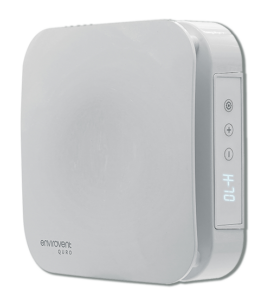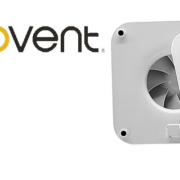EnviroVent, one of the UK’s leading manufacturers of sustainable ventilation systems for residential dwellings, has revealed an exciting new decentralised Mechanical Extract Ventilation (dMEV) unit that is set to take the new build sector by storm.
QURO is set to be a ‘best in class’ product that incorporates the latest fan technology achieving noise levels below 9 dB(A) at 3m. It comes with constant volume technology ensuring that the selected airflow rate is able to be achieved at a range of pressures without manual adjustments.
Performance is guaranteed as EnviroVent’s QURO has low specific fan power (SFP) down to 0.08 W/l/s, which means the fan operates in the most efficient manner. Compliant with Building Regulations Approved Document F for Continuous Extract Ventilation within dwellings, QURO is listed on the SAP PCDB (Product Characteristics Database).
QURO has a stylish, compact low-profile design, making it perfect for the specification and new build market, with the flexibility to be wall or ceiling mounted. It has a small footprint of 175mm x 175mm.
A powerful ventilation unit, QURO is capable of meeting the requirements of all the wet rooms in a property including the kitchen, bathroom, utility, ensuite and WC.
Ruth MacEachern, Product Manager at EnviroVent, explains:
“We are really excited about the release of this innovative new ventilation unit, as part of our commitment to supporting the new build sector. QURO offers low SFP down to 0.08 W/l/s and a maximum power consumption of only 4.5 Watts, making this a leading energy efficient ventilation solution. Housebuilders and specifiers are increasingly seeking ventilation solutions that are compliant with the Future Homes and Building Standard, as well as being compact in design and offering minimal noise disturbance. QURO is the perfect solution for a wide variety of new build applications.”
As part of enhancing energy efficiency, QURO has been aerodynamically optimised and uses a low watt DC motor, providing reduced energy consumption and increased efficiency with enhanced sustainability.
Featuring an Auto Intelligent Timer, QURO automatically varies the over-run timer period, depending upon how long the fan has been in operation. The auto timer can also be turned off and a standard fixed time period timer can be used instead.
It also features Auto Intelligent Humidity, which means the fan speed can respond in direct correlation to changes in relative humidity, therefore enhancing comfort for occupiers.

QURO incorporates integral controls via a display on the side of the unit. This display offers the user the ability to control the unit, including the fan, speed, timer, humidity (model depending) as well as viewing the period of time the fan has been in operation, current running status and any potential errors identified.
QURO has been designed to be low maintenance with no filter needed. Cleaning is simple, as the fan cover can easily be removed and wiped with a cloth to remove any dust or build-up.
QURO is also straightforward to install and provides flexible set up with 5 selectable trickle speeds of 5, 8, 11, 13 and 16l/s, allowing the fan to be commissioned to suit a range of property needs. It also offers a selectable boost speed between 20 and 30l/s which can be selected using the side display.
EnviroVent is the UK’s leading manufacturer of low energy sustainable domestic ventilation systems for the domestic new build market. The company provides housebuilders, developers, specifiers, M&E consultants, contractors and Installers with exceptional technical support to meet Building Regulations and the Future Homes and Building Standard compliance. EnviroVent offers a complete service solution, from providing detailed system design and quotations through to a first class aftercare service. The company has an extensive product range, including MVHR, MEV and DMEV units, Passivhaus-compliant ventilation systems, PIV units, through to extractor fans.
CLICK HERE to find out more about how EnviroVent
helps the new build sector to meet latest requirements
or for more iformation on the QURO DMEV ventilation unit CLICK HERE
![]()




 The alternative is whole site flow reduction. Fitting a device such as Groundbreaker’s NRv2 LoFlo, at the meter regulates the level of flow entering customer premises – regardless of network pressure. As the flow of water into the premises is limited, then the amount used in ‘time controlled’ activities is also limited – but without providing a degradation of service. More importantly not requiring any intervention or behavioural change on the part of the customer, so leading to ‘natural’ reduction in consumption. Our water companies are regulated to provide a minimum level of water supply, but in many areas, due to network structure and gravity fed systems, supply is much greater. Households in high pressure areas could be receiving up to three times the required minimum levels. So, run a hose for five minutes at the bottom of the hill, and your lawn will be greener that the gardener that does the same at the top. ‘Time controlled’ uses could be reduced if all households received the same acceptable, ‘standardised’ supply. Independent research carried out by WRc, showed a theoretical reduction of 2-4% of typical water usage when devices such as LoFlo are installed. However, recent field trials by a major UK water company have showing savings of 5%. As part of UK Net Zero Carbon targets water companies have been targeted to reduce the water householders are using, Per Capita Consumption (PCC). PCC reduction targets average just under 6% in the UK, so utilising property flow restriction could achieve just 1% off the average PPC reduction targets! However, water companies are also tied to customer performance commitment levels (C-Mex), and some seem to be concerned that a reduction in the supply levels to properties will prompt customer complaints, offsetting the financial rewards of achieving PCC targets. Field trials of devices such as LoFlo, have shown that most customers are not aware of supply levels in their property, within certain limits. Especially when moving into a new property, customers accept the levels as ‘being what it is’ and fears of an increase in customer complaints impacting C-Mex values are overrated. In recent trials in England, where occupants did notice the change in supply, it was the positive impact of reduced flow that was cited, e.g. reduced splashing at the kitchen sink. Not a single occupant wanted the LoFLo to be removed after the trial period
The alternative is whole site flow reduction. Fitting a device such as Groundbreaker’s NRv2 LoFlo, at the meter regulates the level of flow entering customer premises – regardless of network pressure. As the flow of water into the premises is limited, then the amount used in ‘time controlled’ activities is also limited – but without providing a degradation of service. More importantly not requiring any intervention or behavioural change on the part of the customer, so leading to ‘natural’ reduction in consumption. Our water companies are regulated to provide a minimum level of water supply, but in many areas, due to network structure and gravity fed systems, supply is much greater. Households in high pressure areas could be receiving up to three times the required minimum levels. So, run a hose for five minutes at the bottom of the hill, and your lawn will be greener that the gardener that does the same at the top. ‘Time controlled’ uses could be reduced if all households received the same acceptable, ‘standardised’ supply. Independent research carried out by WRc, showed a theoretical reduction of 2-4% of typical water usage when devices such as LoFlo are installed. However, recent field trials by a major UK water company have showing savings of 5%. As part of UK Net Zero Carbon targets water companies have been targeted to reduce the water householders are using, Per Capita Consumption (PCC). PCC reduction targets average just under 6% in the UK, so utilising property flow restriction could achieve just 1% off the average PPC reduction targets! However, water companies are also tied to customer performance commitment levels (C-Mex), and some seem to be concerned that a reduction in the supply levels to properties will prompt customer complaints, offsetting the financial rewards of achieving PCC targets. Field trials of devices such as LoFlo, have shown that most customers are not aware of supply levels in their property, within certain limits. Especially when moving into a new property, customers accept the levels as ‘being what it is’ and fears of an increase in customer complaints impacting C-Mex values are overrated. In recent trials in England, where occupants did notice the change in supply, it was the positive impact of reduced flow that was cited, e.g. reduced splashing at the kitchen sink. Not a single occupant wanted the LoFLo to be removed after the trial period